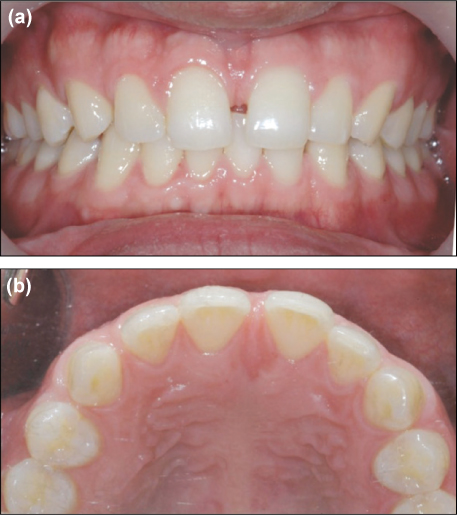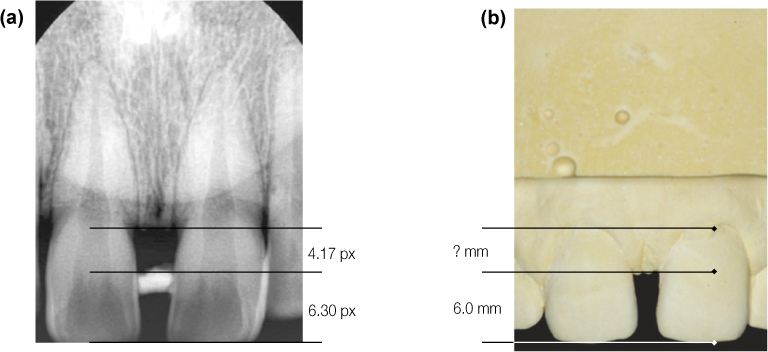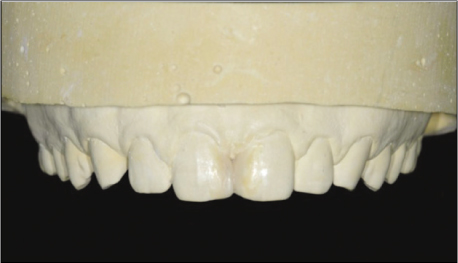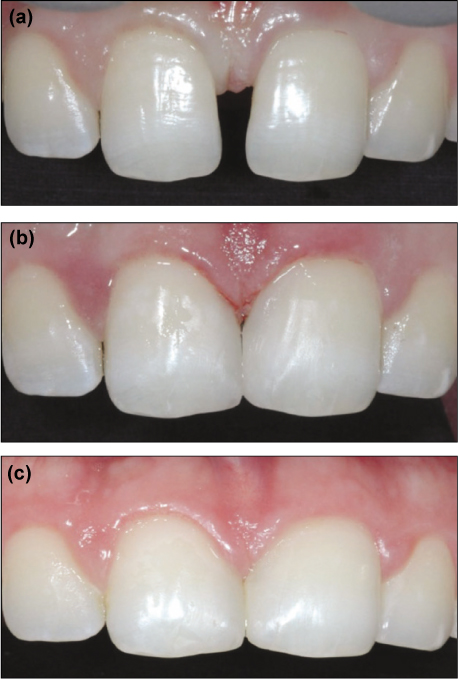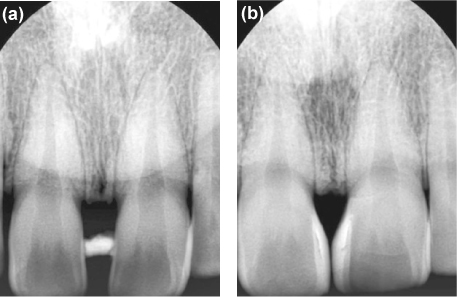J Korean Acad Conserv Dent.
2011 Nov;36(6):515-520. 10.5395/JKACD.2011.36.6.515.
Diastema closure with direct composite: architectural gingival contouring
- Affiliations
-
- 1Department of Conservative Dentistry, Dankook University College of Dentistry, Cheonan, Korea. raindrop@dku.edu
- KMID: 2176609
- DOI: http://doi.org/10.5395/JKACD.2011.36.6.515
Abstract
- One of the most challenging task in closing anterior diastema is avoiding "black triangle" between the teeth. This paper reports a case that the closure of diastema in anterior teeth could be successfully accomplished using direct adhesive restorations and gingival recontouring. The traditional technique using Mylar strip was modified to increase the emergence profile with natural contours at the gingival-tooth interface. Mylar strip was extended out of the sulcus by approximately 1 mm high from the gingival margin, and a small cotton pellet was used to provide the emergence contour. This modified approach is acceptable for the clinical situation.
Figure
Cited by 1 articles
-
Diastema closure using direct bonding restorations combined with orthodontic treatment: a case report
Soon-Kong Hwang, Jung-Hong Ha, Myoung-Uk Jin, Sung-Kyo Kim, Young-Kyung Kim
Restor Dent Endod. 2012;37(3):165-169. doi: 10.5395/rde.2012.37.3.165.
Reference
-
1. Blatz MB, Hürzeler MB, Strub JR. Reconstruction of the lost interproximal papilla-presentation of surgical and nonsurgical approaches. Int J Periodontics Restorative Dent. 1999. 19:395–406.2. Helvey GA. Closing diastemas and creating artificial gingiva with polymer ceramics. Compend Contin Educ Dent. 2002. 23:983–998.3. Tarnow DP, Magner AW, Fletcher P. The effect of the distance from the contact point to the crest of bone on the presence or absence of the interproximal dental papilla. J Periodontol. 1992. 63:995–996.
Article4. Kurth JR, Kokich VG. Open gingival embrasure after orthodontic treatment in adults: prevalence and etiology. Am J Orthod Dentofacial Orthop. 2001. 120:116–123.
Article5. Wu YJ, Tu YK, Huang SM, Chan CP. The influence of the distance from the contact point to the crest of bone on the presence of the interproximal dental papilla. Chang Gung Med J. 2003. 26:822–828.6. Cho HS, Jang HS, Kim DK, Park JC, Kim HJ, Choi SH, Kim CK, Kim BO. The effects of interproximal distance between roots on the existence of interdental papillae according to the distance from the contact point to the alveolar crest. J Periodontol. 2006. 77:1651–1657.
Article7. Martegani P, Silvestri M, Mascarello F, Scipioni T, Ghezzi C, Rota C, Cattaneo V. Morphometric study of the interproximal unit in the esthetic region to correlate anatomic variables affecting the aspect of soft tissue embrasure space. J Periodontol. 2007. 78:2260–2265.
Article8. Chang LC. Assessment of parameters affecting the presence of the central papilla using a non-invasive radiographic method. J Periodontol. 2008. 79:603–609.
Article9. Willhite C. Diastema closure with freehand composite: controlling emergence contour. Quintessence Int. 2005. 36:138–140.10. De Araujo EM Jr, Fortkamp S, Baratieri LN. Closure of diastema and gingival recontouring using direct adhesive restorations: a case report. J Esthet Restor Dent. 2009. 21:229–240.
Article11. Lee DW, Kim CK, Park KH, Cho KS, Moon IS. Non-invasive method to measure the length of soft tissue from the top of the papilla to the crestal bone. J Periodontol. 2005. 76:1311–1314.
Article
- Full Text Links
- Actions
-
Cited
- CITED
-
- Close
- Share
- Similar articles
-
- Conservative and esthetic closure of maxillary midline diastema without creating "black triangle" using direct resin composite
- Clinical study on the relapse of diastema
- Diastema closure using direct bonding restorations combined with orthodontic treatment: a case report
- The effect of the amount of interdental spacing on the stress distribution in maxillary central incisors restored with porcelain laminate veneer and composite resin: A 3D-finite element analysis
- Alterations of papilla dimensions after orthodontic closure of the maxillary midline diastema: a retrospective longitudinal study

